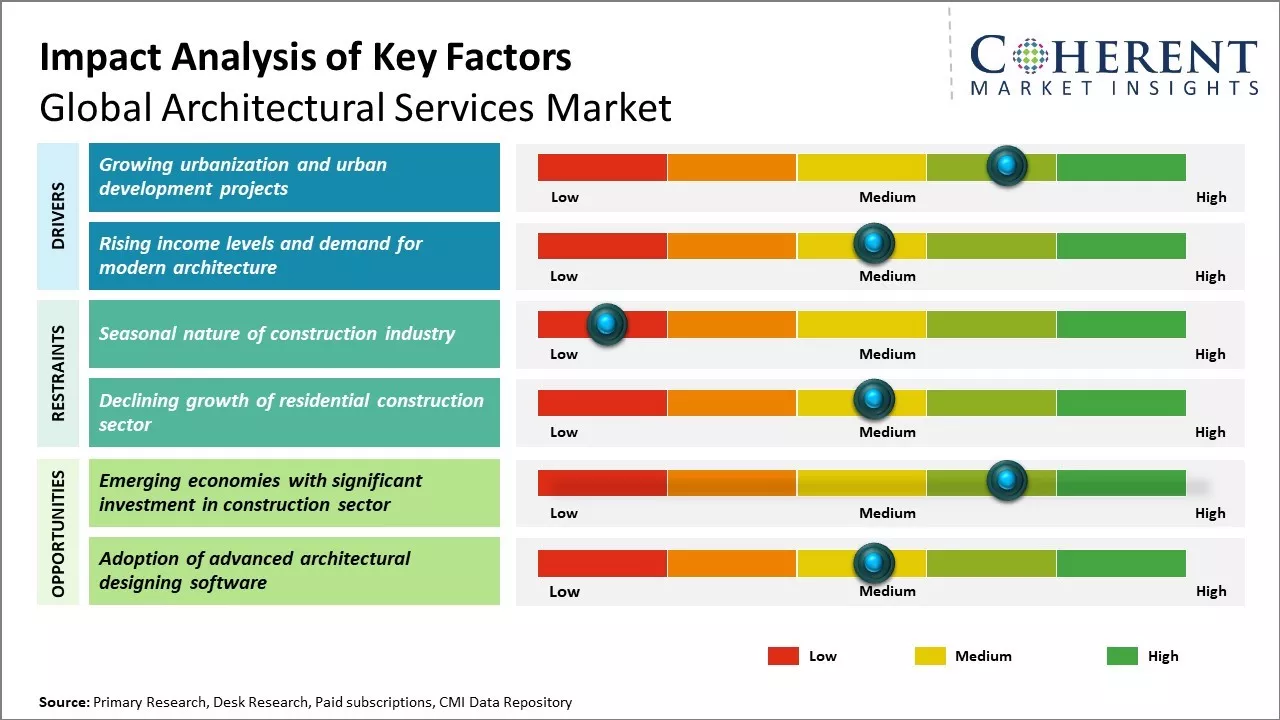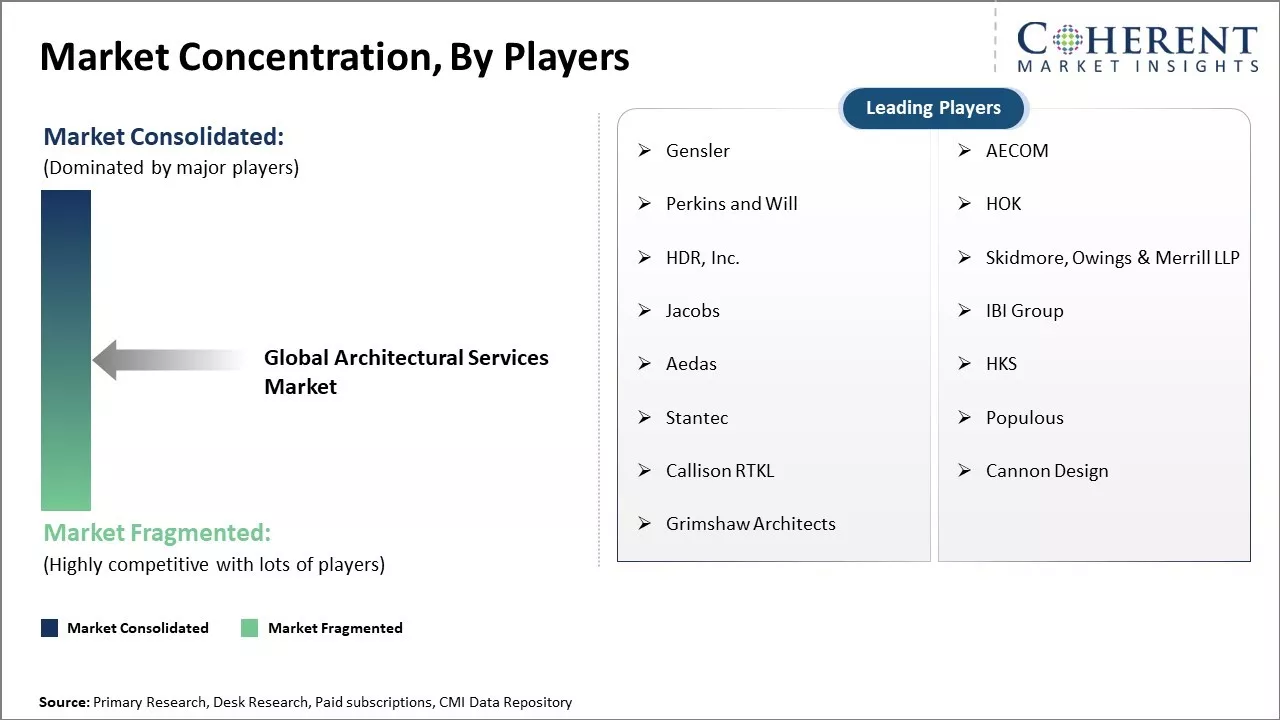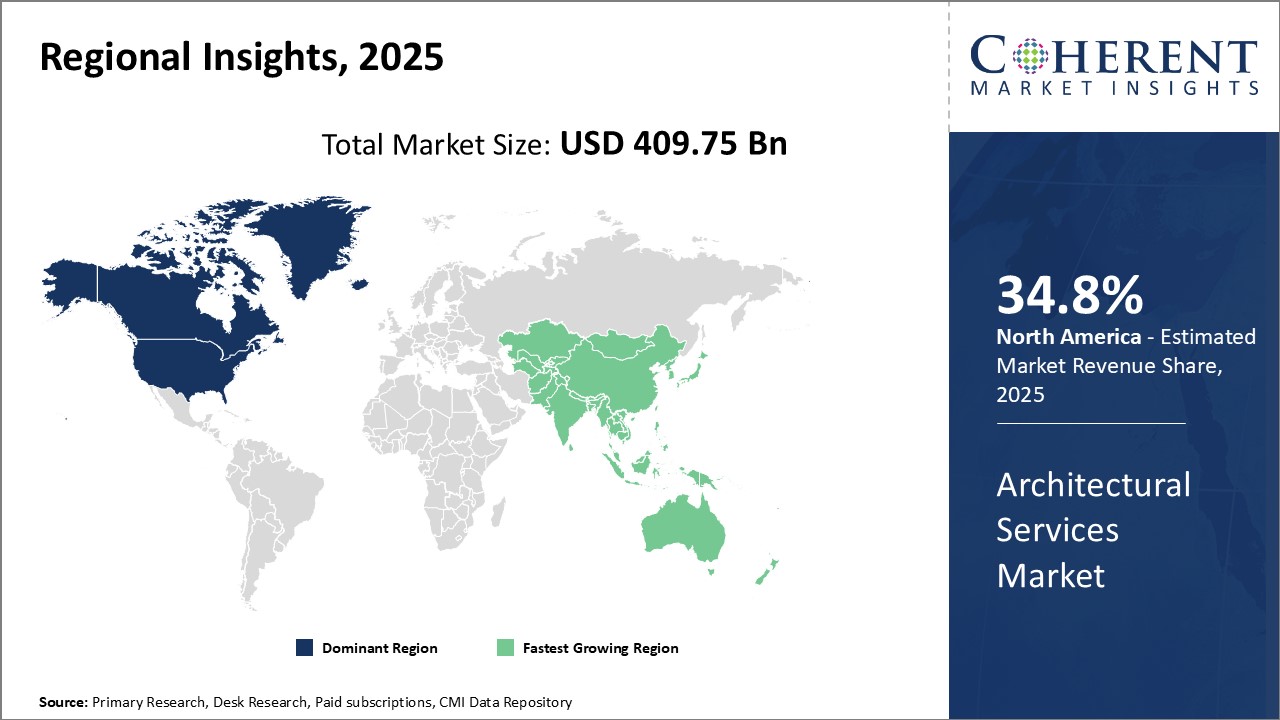Architectural Services Market Size and Trends
The global architectural services market is estimated to be valued at US$ 409.75 Bn in 2025 and is expected to reach US$ 600.41 Bn by 2032, exhibiting a compound annual growth rate (CAGR) of 5.6% from 2025 to 2032.

Discover market dynamics shaping the industry: Download Free Sample
The architectural services market is expected to grow steadily over the next few years. The rising population globally has increased the demand for residential and commercial construction spaces. Additionally, increased investments by various governments and private organizations in public infrastructure such as roads, railways, hospitals, and schools will also propel the growth of the architectural services market during the forecast period. With rapid urbanization, many developing nations are focusing on improving their infrastructure which is anticipated to boost the need for architectural services worldwide. Furthermore, growing environmental concerns have spurred the demand for green buildings, which require extensive architectural planning, thereby driving the market growth.
Growing urbanization and urban development projects
As the world population continues to grow exponentially, urbanization is also increasing at a tremendous rate. More and more people are migrating to cities in search of better livelihood opportunities and improved quality of life.
Country governments and private real estate developers are investing huge sums of money to develop smart cities, expand existing cities and set up special economic zones. In India, the government's ambitious 'Housing for All by 2022' initiative aims to construct over 80 million affordable houses in urban and rural areas. Many Gulf countries are also aggressively developing new cities and urban centers. All these large-scale urbanization efforts are driving tremendous demand for experienced architectural firms that can plan, design and implement diverse real estate and construction projects as per global standards and local needs. The scope and scale of work is much larger than before, benefiting top architecture companies.
For instance, in December 2020, IBI Group, a Canadian-based architecture, engineering, planning, and technology firm acquired the assets of Cole Engineering Group, a engineering consulting firm. This strategic move is aimed to enhance IBI's capabilities and competitiveness across all areas of its business, allowing the company to deliver a broader range of services to its major public-sector projects and deepen its relationships with private-sector developer clients.
Market Concentration and Competitive Landscape

Get actionable strategies to beat competition: Download Free Sample
Rising income levels and demand for modern architecture
Another key driver for the architectural services Market is the rising disposable income levels of consumers and their increasing aspirations for beautiful homes and offices. As living standards improve globally, both individuals and corporations are willing to pay more to incorporate innovative and aesthetically appealing designs into their properties. There is a growing preference for open plan layouts, ample natural lighting, smart, and eco-friendly features. People also want residential and commercial buildings that match international quality standards and brands. This has augmented the requirement for professional architectural expertise that understands global trends and can transform blueprints into breath-taking structures.
Higher income consumers in emerging markets like China, Brazil, India are fueling strong demand for luxurious villas, farmhouses, penthouses and glass facade offices. Even mid-income groups want upgraded designs and facilities in their projects. Architects thus need to constantly refine and diversify their skills according to the project budget and client needs.
Key Takeaways from Analyst:
Rising construction of commercial and residential buildings worldwide will be a key driver for the market. Recovery of the construction sector in developed regions post COVID-19 and ongoing infrastructure development projects will augment demand. Further fueling growth are investments in smart city initiatives by various governments.
However, market growth could be restrained by economic uncertainties brought on by geopolitical issues and rising interest rates. Highly regulated nature of the industry poses challenges as well. Architectural firms also face stiff competition from in-house design teams of major construction players and developers.
North America will likely retain its leading position in the global architectural services market supported by strong architectural spending in the U.S. Asia Pacific is predicted to emerge as the fastest growing regional market. This can be attributed to ambitious construction plans underway in major Asian economies like China and India. Western Europe is also anticipated to offer lucrative opportunities driven by revitalization programs underway across countries.
Overall, the architectural services industry remains buoyant over the long term given the essential need for buildings and structures. Digitalization trends are enabling architectural firms to provide more streamlined and collaborative services. Consolidation activities among industry players are further heating up competition.
Market Challenges: Seasonal nature of construction industry
The seasonal nature of construction industry poses a significant challenge for the steady growth of the global architectural services market. Being inherently tied to the construction business, architectural firms see fluctuations in their revenue and workload throughout the year depending on the weather and climate conditions that impact construction activities.
Most countries experience slower construction periods during winter months due to harsh weather conditions like heavy snowfall, rains or freezing temperatures which obstruct smooth ongoing of construction projects. This leads to reduced demand for architectural design and consultancy services from real estate developers and construction companies during these periods. Consequently, the profits and revenues of architectural companies tend to vary considerably each quarter. Managing overheads and fixed costs with such unpredictable cashflows proves difficult. This affects their long-term business planning and hiring/investment decisions.
Market Opportunities: Emerging economies with significant investment in construction sector
Emerging economies with rapidly growing construction sectors present a major opportunity for the global architectural services market. Countries like India, Indonesia, Philippines, and Vietnam are urbanizing rapidly and have ambitious plans for infrastructure development over the next decade. Large scale projects around transportation, urbanization, renewable energy, and sustainable development are planned in these regions. Local construction firms will need expertise from global architectural giants to design and plan complex, large scale projects adhering to global standards and best practices. International architects can help emerging markets address challenges of rapid urbanization more sustainably and efficiently through innovative, transit-oriented development designs.

Discover high revenue pocket segments and roadmap to it: Download Free Sample
In terms of services, construction and project management services contributes the highest share of the market owing to increasing infrastructure development projects
The construction and project management services segment is expected to hold the 33.6% share in 2025 for the architectural services market owing to the rising number of infrastructure development projects across the globe. Mega infrastructure projects related to transportation, power and energy, commercial spaces, and public facilities are boosting the demand for construction management and oversight.
Government emphasis on public infrastructure upgrading coupled with growing private investments in commercial real estate is propelling the scope of construction project management. Complex nature of infrastructure projects necessitates experienced construction managers and architects to coordinate various project phases and ensure timely completion within budget. Their value adding services in project planning, cost and schedule control, quality monitoring and risk assessment are highly sought after.
Rapid urbanization also requires efficient construction of residential and civic amenities which is spurring the need for architectural supervision and guidance at each phase. Furthermore, technology adoption in project management tools is allowing real-time collaboration between stakeholders and automated tracking of resources. This is positively impacting the growth dynamics of construction and project management services segment.
In terms of end-use industry, industrial contributes the highest share of the market owing to the expansion of the manufacturing sector
The industrial segment dominates the architectural services market with 42.6% share in 2025 owing to large-scale investments towards industrialization. Continuous global economic growth especially in emerging nations is driving the augmentation of manufacturing infrastructure and facilities.
Multinational companies are setting up new plants or expanding existing units in different industry verticals such as automotive, chemicals, metals, machinery etc. This requires architectural expertise for the design, layout and construction of industrial buildings, production units and allied structures. Safety and efficiency compliant designs prepared by architects are essential for establishing manufacturing operations.
Moreover, adoption of advanced technologies in industrial settings places important requirements such as process optimization, automation integration, material handling assessments etc. which are addressed through value-added architectural solutions. Growing 'Make in India' initiative and China's thriving manufacturing prowess have also propelled the demand for industrial architectural services in Asia Pacific.
Strict compliance to Quality Management Systems (QMS) in production places further demand for certification consultations from architects. Hence, industrial sector expansion stands as a key driver boosting the largest share of architectural services in the global architectural services market.
Regional Insights

Need a Different Region or Segment? Download Free Sample
North America has long been the dominant region in the global architectural services market with 34.8% share in 2025. With some of the world's largest architectural firms based in major cities like New York, Chicago, and Los Angeles, the industry presence and reputation of North American companies is unparalleled globally. Many iconic buildings around the world were designed by American architects, cementing their leadership in modern architecture.
While the scale and experience of North American firms gives them an advantage, their pricing is generally on the higher side compared to other regions. However, clients are willing to pay this premium for the brand name, cutting edge designs and proven track record that these firms offer. Exports of architectural services have been a major revenue generator for the region. Many firms also have overseas offices that allow them to better serve international clients.
The Asia Pacific region has emerged as the fastest growing market for architectural services in recent years. Rapid urbanization and infrastructure development across developing nations like China, India and Indonesia have spurred tremendous demand for architecture and construction. Given the enormous addressed market, many regional and global players have been aggressively expanding their operations in Asia Pacific.
Countries in Asia Pacific offer lower costs for architectural work compared to mature markets. Local firms in particular have been able to leverage their familiarity with regional building practices and lower wage structures to drive growth. While quality and brand reputation still lag the benchmark set by Western giants, Asian architectural talent is fast catching up by taking on ambitious and high-profile projects both domestic and abroad. Growing exports of construction materials and building components from the region have further complemented this expansion.
Market Report Scope
Architectural Services Market Report Coverage
| Report Coverage | Details | ||
|---|---|---|---|
| Base Year: | 2024 | Market Size in 2025: | USD 409.75 Bn |
| Historical Data for: | 2020 To 2024 | Forecast Period: | 2025 To 2032 |
| Forecast Period 2025 to 2032 CAGR: | 5.6% | 2032 Value Projection: | USD 600.41 Bn |
| Geographies covered: |
|
||
| Segments covered: |
|
||
| Companies covered: |
Gensler, AECOM, Perkins and Will, HOK, HDR, Inc., Skidmore, Owings & Merrill LLP, Jacobs, IBI Group, Aedas, HKS, Stantec, Populous, Callison RTKL, Cannon Design, and Grimshaw Architects |
||
| Growth Drivers: |
|
||
| Restraints & Challenges: |
|
||
Uncover macros and micros vetted on 75+ parameters: Get instant access to report
Architectural Services Industry News
- In October 2023, Huawei introduced the Full-stack, AI Large Model, Service Engine, Transformation (FAST) reference architecture to help carriers undergo digital operations transformation in the digital intelligence era. This architecture is designed to leverage the unique advantages of carriers' full-stack capabilities across services, cloud, network, and intelligence. The goal is to enable new value-driven operations and maintenance, provide optimal scenario-based experiences, and foster the business agility needed to create greater value.
- In April 2023, the City of Port Aransas in Texas, U.S. selected Stantec to lead a restoration plan for 13.5 acres of ecosystems within the Nature Preserve at Charlie's Pasture, which has been underwater since Hurricane Harvey damaged the shorelines in 2017. The Stantec team will manage the project, focusing on enhancing visitor use, wildlife ecosystems, and resilience mechanisms for future storm surges. The team will also identify sediment sources, analyze local marsh conditions, and quickly deploy personnel to begin the restoration process.
- In March 2023, HKS launched a new partner diversity initiative called HKS "xBE" to foster inclusion in the architecture and design industry. This program includes a 12-week seminar called "xBE" Rise and an "xBE" Network, which aims to enhance diversity among the firm's collaborations and partnerships. HKS is dedicated to building a more diverse workforce and network across the AEC industry.
- In January 2023, ACEN Australia, a renewable energy company, awarded PCL Construction the Engineering, Procurement and Construction (EPC) contract for the 400 MW Stubbo Solar projects. Under this contract, PCL Construction will be responsible for overseeing the entire solar project, including the detailed design, engineering, and procurement.
- In January 2023, PCL Construction was awarded the Engineering, Procurement and Construction (EPC) contract by ACEN Australia to build the 400 MW Stubbo Solar projects, which includes detailed design, engineering, and procurement responsibilities, ensuring PCL's comprehensive involvement in the project's execution.
- In March 2021, HOK and Arup collaborated with Los Angeles World Airports (LAWA) and Van Nuys Airport (VNY) to provide key architectural and engineering services. As part of this collaboration, HOK and Arup will be responsible for planning and designing potential capital investment projects over the next three years.
*Definition: The global architectural services market offers architectural and engineering design services for both residential and commercial spaces. Architectural firms in this market provide consultation for new construction projects as well as redevelopment and renovation work. They help clients with schematic design, design development, construction documents preparation, code research, and permit processing. Services include spatial planning, interior design, sustainable design strategies, and project management. The market serves various industries including real estate, healthcare, education, hospitality, and retail.
Market Segmentation
- Services Insights (Revenue, US$ Bn, 2020 - 2032)
- Architectural Advisory Services
- Construction And Project Management Services
- Engineering Services
- Interior Design Services
- Urban Planning Services
- Building Code Counseling And Interpretation Consulting Services
- Legal Technical Requirement Compliance Counseling Services
- Others
- End-use Industry Insights (Revenue, US$ Bn, 2020 - 2032)
- Education
- Government
- Healthcare
- Hospitality
- Residential
- Industrial
- Retail
- Others
- Regional Insights (Revenue, US$ Bn, 2020 - 2032)
- North America
- U.S.
- Canada
- Latin America
- Brazil
- Argentina
- Mexico
- Rest of Latin America
- Europe
- Germany
- U.K.
- Spain
- France
- Italy
- Russia
- Rest of Europe
- Asia Pacific
- China
- India
- Japan
- Australia
- South Korea
- ASEAN
- Rest of Asia Pacific
- Middle East & Africa
- GCC Countries
- Israel
- South Africa
- Rest of Middle East & Africa
- North America
- Key Players Insights
- Gensler
- AECOM
- Perkins and Will
- HOK
- HDR, Inc.
- Skidmore, Owings & Merrill LLP
- Jacobs
- IBI Group
- Aedas
- HKS
- Stantec
- Populous
- Callison RTKL
- Cannon Design
- Grimshaw Architects
Share
Share
About Author
Monica Shevgan has 9+ years of experience in market research and business consulting driving client-centric product delivery of the Information and Communication Technology (ICT) team, enhancing client experiences, and shaping business strategy for optimal outcomes. Passionate about client success.
Missing comfort of reading report in your local language? Find your preferred language :
Transform your Strategy with Exclusive Trending Reports :
Frequently Asked Questions
EXISTING CLIENTELE
Joining thousands of companies around the world committed to making the Excellent Business Solutions.
View All Our Clients
